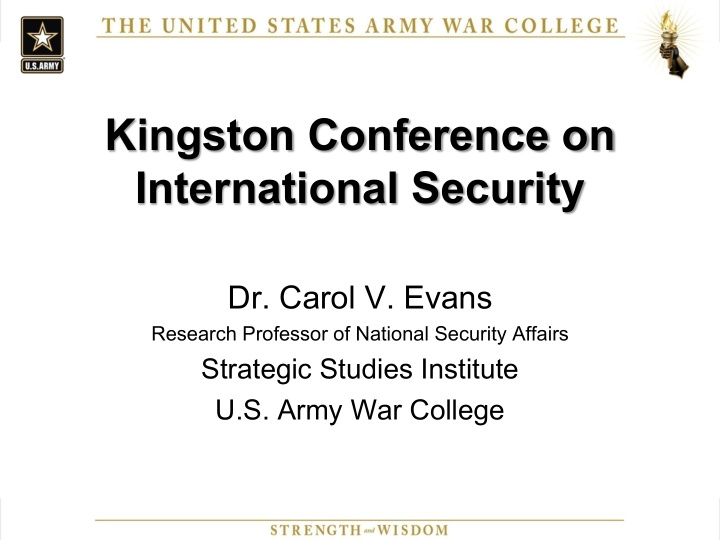



Kingston Conference on International Security Dr. Carol V. Evans Research Professor of National Security Affairs Strategic Studies Institute U.S. Army War College
The Economic Drivers • Economic drivers are paramount in reshaping the international security landscape. • Nation states are using economic tools as their primary means of projecting influence and conducting geostrategic combat in the 21 st century. • Geopolitical competition is being determined by how effectively nation states wield those economic weapons.
Key Economic Drivers of Change • U.S. Retreat from Multilateralism • China’s ascendance to global pre-eminence via the Belt & Road Initiative • Weaponization of critical infrastructure to challenge the U.S. & NATO
U.S. Retreat from Multilateralism • Withdrawal from or renegotiate multilateral trade frameworks – Trans Pacific Partnership – NAFTA – India/GSP – KORUS – WTO • Encourage BREXIT • Trade Wars and Punitive Economic Sanctions • Unintended consequences impacting international security
China’s Belt & Road Initiative (BRI) “ Europe-Asia land bridge to form a greater Euro- Asian symbiotic economic belt and use the countless economic links and common interests with countries to the West in order to dismantle the U.S. encirclement of China .” PLA General Liu Yazhou, cited in China’s Eurasia Strategy.
Belt & Road Initiative • Launched in 2013 by Xi Jinping. • Silk Road Economic Belt and 21 st Century Maritime Silk Road collectively referred to as One Belt One Road or BRI. • Global network of ports, railways, roads & bridges, pipelines, industrial parks and sea lines of communication. • Nearly 80 countries: 4.4 billion people roughly 63% of world’s population, combined GDP of $21 trillion.
PRC Geostrategic Goal Establish control of vital strategic maritime chokepoints, arteries and ports. • PLA/PLAMC military base in Djibouti - a choke-point for the Suez Canal and Red Sea. • 2017 Panama Canal treaty and port development for the PLAN • Berthing agreements in Malaysia near the Strait of Malacca • Port agreements in Gwadar, Pakistan and Hambantota in Sri Lanka
BRI Impacts to U.S & NATO • China’s BRI strategy challenges U.S./NATO force projection & sustainment capabilities • Threatens energy supply chains for forward deployed U.S. and NATO forces • Counters U.S. pivot to Asia- Pacific & contains India • Undermines U.S. credibility with key allies in Africa and Asia
Weaponizing CI to Challenge the U.S. & NATO • Our adversaries are exploiting vulnerabilities in U.S., NATO and global CI to prepare the battlespace and threaten U.S./NATO military supremacy. • Use of CI as an weapon of choice: – Russian hybrid warfare in Ukraine – Adversarial cyber penetration of the U.S. electric grid and other CI sectors on which DoD operations and installations depend. – Chinese foreign investment in strategic CI sectors such as telecommunications, transportation and the defense industrial base in the U.S. and Europe
• “ The smart thing to do is to …attack the critical infrastructure, the facilities here in the United States on which we depend to deploy, operate and sustain our forces abroad.” Dr. Paul Stockton, former Assistant Secretary of Defense for Homeland Defense and Americas' Security Affairs • “It does not matter how capable, how well- trained or how advanced a nation’s forces are if they can’t get to the front in time.” Omar Lamrani, in Stratfor, “Why Logistics will be key to any U.S. Conflict with Russia and China.”
Foreign Investment “ The degree and impact of foreign direct investment in strategic sectors – such as airports, sea ports, energy production and distribution, or telecoms – in some Allied nations raises questions about whether access and control over such infrastructure can be maintained, particularly in crisis when it would be required to support the military.” NATO, Resilience: The First Line of Defence.
Recommend
More recommend